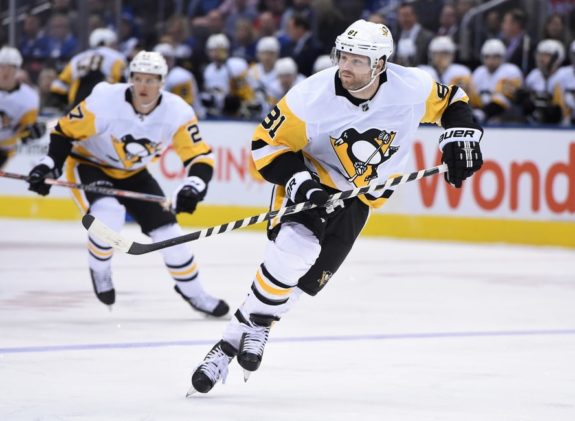The Pittsburgh Penguins inched closer to a playoff berth by earning five of eight possible points this week, but things could’ve, and should’ve, gone better than they did. However, with the Montreal Canadiens fading from contention, the Penguins still exited the week seven points clear in a playoff spot.

The team started strong on Tuesday night in their final matchup of the season against the Washington Capitals. After going down 2-0 midway through the second period and looking lethargic to that point, the Penguins exploded for three goals, one from Jake Guentzel and two from Sidney Crosby, in less than two minutes to go up 3-2. It was a lead they wouldn’t give up en route to a 5-3 victory. History was made on Phil Kessel’s third-period power-play goal as a secondary assist from Evgeni Malkin gave him 1,000 points on his career.
The team then traveled to take on the Buffalo Sabres on Thursday night and dominated with a 5-0 victory as Casey DeSmith made 26 saves for his third shutout of the season.
Things took a rough turn on the weekend during back-to-back contests against the St. Louis Blues on Saturday and the Philadelphia Flyers on Sunday.
Despite firing 41 shots on Blues’ goaltender Jordan Binnington, the Penguins were a no-show on defense and ended up losing 5-1. On Sunday, things should’ve ended much better. Goaltender Carter Hart stood on his head for the Flyers, stopping 41 of 42 shots, keeping the game close and allowing James Van Riemsdyk to tie the game with 18 seconds left. Sean Couturier ended the game with 3.4 seconds left in overtime after a horrid play by Crosby gave the Flyers a 2-on-1 and Couturier put it under Matt Murray’s blocker to give his team a 2-1 victory.
It was a disappointing end to what could’ve been a strong week, and the news only got worse when the Penguins discovered they would be without a star forward long term. They also need another star to snap his slump, while their big NHL Trade Deadline acquisition has been a pleasant surprise. All that in this week’s edition of Penguins Pulpit.
Malkin’s Milestone Week Ends on Sour Note
A week of celebrations for Malkin after becoming a member of the 1,000 career point club against the Capitals ended in disaster following the announcement he’d miss significant time with an injury. Let’s start with the good part of the week, however.
Beginning Tuesday’s game with 998 points, Malkin got 999 with a secondary assist on Crosby’s power-play goal with under six minutes left in the second period. From that point on, it was clear he wanted to reach the milestone immediately. He almost scored it after breaking through multiple Capitals skaters but was stopped by goaltender Braden Holtby. Finally, after numerous chances, Malkin recorded his 1,000th career point with a secondary assist on Kessel’s power-play goal at 11:56 of the third period that put the Penguins up 4-2.
The game was stopped briefly as the Penguins, fans, and all those in attendance congratulated the 32-year-old on becoming the 88th player, and fourth Penguin, to join the club. He’s also the second Penguin to join in the last two seasons as Crosby got his 1,000th on Feb. 16, 2017, against the Winnipeg Jets.
Related: Penguins Make March a Month of Milestones
Congratulations to Evgeni Malkin on becoming the 88th player in NHL history to reach 1,000 points. What an incredible career accomplishment. #Ma1Kin pic.twitter.com/5ntZ6CQC56
— Pittsburgh Penguins (@penguins) March 13, 2019
It seemed as if Malkin was going to hit every unlucky break on his way to the milestone and he felt the same way. He expressed his relief in finally getting there after Tuesday’s game:
Like, finally. Last couple weeks I’m a little bit nervous,” Malkin said. “It’s like a little bit slow, but it’s finally over, 1,000. I breathe normally. Thanking my teammates. Special day for my family, my friends.
On paper, it seems like it’s taken him longer than expected, but he’s missed a lot of time over his career due to injury. When you look at the numbers, he arrived right on time. Among players with 1,000 points, Malkin has the 11th best points per game at 1.18 and is second among active players.
Overshadowed by Crosby for most of his career, Malkin has dominated the NHL for as long as he’s been around and doesn’t look like he’s finished adding to his resume quite yet.
Related – Evgeni Malkin: The Superstar That No One Notices
Unfortunately, the week didn’t end as well as it started.
During the first period of Saturday afternoon’s game against the Blues, Malkin took a crosscheck to the ribs from defenseman Robert Bortuzzo and dropped to the ice in pain. He stayed down for a few minutes, but eventually got up and played the remainder of the game, so you might’ve assumed he simply had the wind knocked out of him.

It wasn’t until he wasn’t on the ice for warmups before Sunday night’s game against the Flyers that the concerns grew. He didn’t play and head coach Mike Sullivan announced following the Penguins’ loss that he’d be out week-to-week with an upper-body injury. No specifications were made beyond a UBI, but it’s likely Malkin either bruised or broke a rib. It’s another case of a Penguin getting injured and playing the remainder of the game before being ruled out long-term.
With the playoffs just over three weeks away, time will be working against him to be ready for the first game of the Penguins’ postseason run. It’s the third time in the last four seasons Malkin’s regular season ended in mid-March, although the Penguins won the Stanley Cup the last two times it happened, in 2015-16 and 2016-17.
Still, it’s the worst possible timing. While it hasn’t been Malkin’s finest season with 71 points in 66 games, but that a point-per-game pace can be considered an off-season is a testament to how good he is, one of the best in the league. The Penguins need him at full-strength to make any serious postseason run, and they need him to help the team earn home-ice advantage. With just three and four-point leads over the wild card Carolina Hurricanes and Columbus Blue Jackets, respectively, there’s a chance the Penguins could drop down from a divisional spot if they struggle in his absence.
A wild-card spot wouldn’t necessarily be the end, though. If they fall to the first wild-card spot, they’d play either the Capitals or New York Islanders in the first round and remain in the Metropolitan postseason bracket, albeit without home-ice. If they fall to the second wild-card, that’s where things could get messy.
Falling to the eighth seed in the Eastern Conference would put the Penguins up against the Presidents’ Trophy-winning Tampa Bay Lightning, who look ready to steamroll everybody in their path, in the first round. It would also put them in the Atlantic Division bracket which means that if they beat the Lightning, they’d have to face either the Toronto Maple Leafs or Boston Bruins in the second round if they make it that far; not exactly an ideal scenario for any team.
The injury will put even more pressure on Crosby and Guentzel to produce down the stretch to keep their playoff spot. It’ll also require other players to step up, and some players will need to bust their slumps, namely Kessel and Patric Hornqvist.

Unless the Penguins collapse, they’ll make the playoffs. So at least that weight is off their shoulders. But Malkin’s absence could be the difference between an easier first-round matchup with home-ice advantage or a date with the best team in the league.
Kessel’s Struggles Becoming a Problem
Back in early 2015, one of Kessel’s coaches during his time with the Maple Leafs, Ron Wilson, said Kessel was a guy that’d be on for two weeks and off for two weeks. While the criticism was harsh, it wasn’t exactly wrong. He does tend to be the best player on the ice one night and a ghost the next. Wilson also called him “uncoachable,” and while I wouldn’t agree with that, I do believe he can be a difficult guy to coach because he likes to go at his own pace.
While not because of Wilson, the two weeks on, two weeks off comment has been a topic of discussion since mid-December. I’ve stayed away from it because Kessel’s earned the benefit of the doubt, but with the playoffs inching closer the question needs to be asked: what’s wrong with him?
He was on pace for a career-high 96 points after his third consecutive three-point performance on New Year’s Eve but has been extremely hot and cold since then, with 27 points in 34 games. The production is fine on the surface — it’s only slightly below his career average and a 65-point pace over a full season. But, when you look at it under a microscope and how he’s played, that’s where the problems arise.

There are nights he’s looked like vintage Kessel, and the puck follows him around as he pounds opponents with opportunity after opportunity, such as his performance against the Sabres back on March 1, when he fired seven shots on net and was all over the ice. However, on most nights, he’s been more of a hindrance than a help for the Penguins, like his performance against the Flyers on Sunday when he was a trainwreck at even strength and on the power play in the team’s loss.
It’d be easy to look at the numbers and brush it off as nothing, but you can’t. He hasn’t been good enough; it’s that simple. He’s a one-dimensional player, and when he’s not making an impact on offense, he’s not helping much. It’s unfair to accuse players of taking a shift off, but it’s clear Kessel gives more on some shifts than others.
Still, it’s not the first time he’s struggled in the second half as a member of the Penguins, but it’s a significant issue. These are his second-half statistics during his time with the team.
- 2015-16: 38 points in 45 games, 26 even-strength points, 12 power play points, 19/45 games (42%) without a point
- 2016-17: 32 points in 44 games, 18 even-strength points, 14 power play points, 19/44 games (43%) without a point
- 2017-18: 50 points in 42 games, 31 even-strength points, 19 power play points, 14/42 games (33%) without a point
- 2018-19: 27 points in 34 games, 15 even-strength points, 12 power play points, 15/34 games (44%) without a point
You might notice something here: the previous two times, the 2015-16 and 2016-17 seasons, where Kessel failed to record a point in more than 40 percent of his second-half games, the Penguins won the Stanley Cup. Could it happen again this season? It’d take a miracle, but it’s still an interesting tidbit.
He’s known as a power play specialist, so it does not surprise that the difference between his even-strength and man-advantage production isn’t large. But he’s never been this reliant on the power-play, especially since he scored his last even-strength goal back on Jan. 30 against the Lightning.
In the 23 games since then, Kessel has nine even-strength points, all assists, and nine power-play points, three goals, six assists. All three of those goals came during a five-game stretch after breaking his 16-game goalless drought on March 7 against the Blue Jackets. To get a grasp of how bad his struggles have been, he has as many faceoff wins (three) as he does goals over the last six weeks.
The biggest problem for the Penguins is they’re not as good as they were two years ago. They can’t afford to have Kessel turning into a ghost for long periods, especially if it continues into April. Of course, if he returns to his 2016 and 2017 playoff versions of himself, his late struggles will be forgotten. But if he carries this level of play into the postseason, some questions may need to be asked about his future as a member of the team. He’s a streaky player; everybody knows that. But he needs to be much better following the news on Malkin.
Gudbranson Has Been “Goodbranson”
Perhaps the move from the Vancouver Canucks has helped more expected.
Many people, myself included, were pessimistic about the Penguins’ acquisition of Gudbranson back on deadline day, but he’s proved the doubters wrong in his first ten games with the team. In a time when the Penguins have desperately needed their defensemen to step up in the absence of Kris Letang, Gudbranson has done just that. Outside of Brian Dumoulin, he’s arguably been the team’s most consistent blueliner.
In his ten games, the 27-year-old has one assist while averaging 20:03 per night — just over two minutes more than he did in Vancouver. The points aren’t important, he’s never going to produce at a high clip, but his defense has turned around.
Expectations weren’t high, any level of competency would’ve sufficed, but he’s gone above and beyond. He’s made few mistakes and has generally been above-average in his zone while doing a fantastic job keeping opponents out of high-danger areas, or any potential scoring area at all.

His advanced numbers have also been outstanding since he joined the team; in fact, they’ve been the best among all Penguins skaters. Gudbranson’s Corsi For % (CF%), Fenwick For % (FF%) and Scoring Chances For % (SCF%) have only been below 50% twice, and his Shots For % (SF%) and High-Danger Chances For (HDCF%) have been below 50% only once in his first ten games with the team. Here’s how his five-on-five numbers rank among current Penguins’ skaters with ten games played.
- CF%: 173 CF-135 CA (56.2%), first
- FF%: 130 FF-96 FA (57.5%), first
- SF%: 107 SF-78 SA (57.8%), first
- Goals For %: 4 GF-4GA (50%), 20th
- SCF%: 92 SCF-63 SCA (59.4%), first
- HDCF%: 45 HDCF-19 HDCA (70.3%), first
So, yes, he’s been good both with the eye-test and analytically. Something to note: an on-ice shooting percentage of 3.74 hurts Gudbranson’s GF% during his time with the team. When regression to the mean comes, he’ll see a boost in the goals-for category.
Known as an anchor for most of his career, that’s also changed in Pittsburgh. Only three skaters, Bryan Rust, Dominik Simon, and Nick Bjugstad, have a CF% better than 51% while playing away from him, whereas Gudbranson holds a CF% above 53% playing away from anybody on the roster. Whether Gudbranson keeps it up remains to be seen, but he’s been a welcome addition on the Penguins’ blueline.
In what’s good news for the Penguins and bad news for Gudbranson, his role is going to be reduced with the return of Letang, who could be back in the lineup as soon as Tuesday night against the Hurricanes. But if Gudbranson can keep up his current level of play, he’ll continue to make a positive impact on the lineup.
While the Penguins may get Letang back in the immediate future, they’re without a generational talent at center for the long-term as they enter a final nine games of the season. On tap for this week is the first three games of their four-game road trip with games against the Hurricanes, Nashville Predators and Dallas Stars.
What’s Up Next
3/19/19 @ Carolina Hurricanes
3/21/19 @ Nashville Predators
3/23/19 @ Dallas Stars
Advanced Stats via Natural Stat Trick